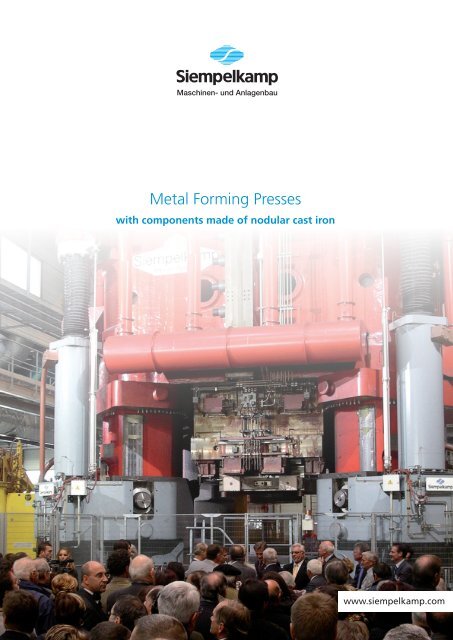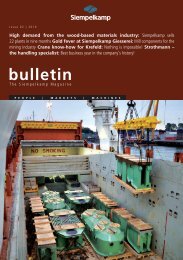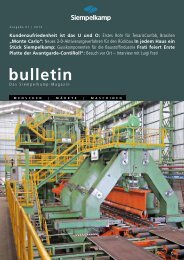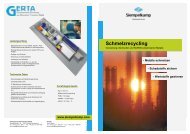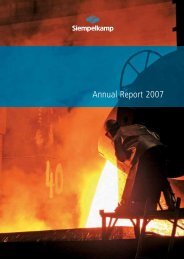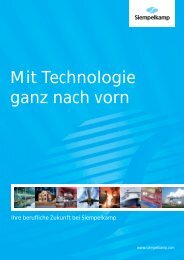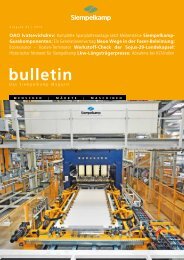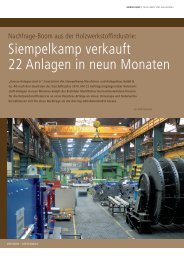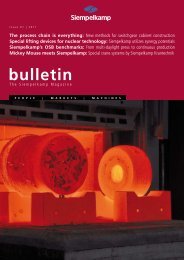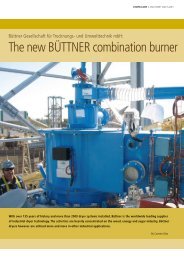Metal Forming Presses - Siempelkamp
Metal Forming Presses - Siempelkamp
Metal Forming Presses - Siempelkamp
You also want an ePaper? Increase the reach of your titles
YUMPU automatically turns print PDFs into web optimized ePapers that Google loves.
Maschinen- und Anlagenbau<br />
<strong>Metal</strong> <strong>Forming</strong> <strong>Presses</strong><br />
with components made of nodular cast iron<br />
www.siempelkamp.com
Each extra-large press is one of a kind<br />
A large press is not purchased every day<br />
Before a new machine, which was<br />
produced in serial production, is<br />
introduced to the market, the ma-<br />
nufacturers will test prototypes and<br />
initial batches thoroughly. Many<br />
details are optimized in this way<br />
before serial production starts.<br />
For large presses this is completely<br />
different. In their performance<br />
class every machine is unique.<br />
Oftentimes a press represents the<br />
backbone of a factory. If it is not<br />
working, production comes to a<br />
standstill.<br />
The conclusion:<br />
This means that from the day<br />
the press is put into operation<br />
it has to work reliably, efficiently,<br />
and precisely day in and<br />
day out for many decades.
References<br />
125 years of <strong>Siempelkamp</strong> – experienced, competent, and flexible<br />
<strong>Siempelkamp</strong> has the experience<br />
of many decades in the design<br />
and construction of metal forming<br />
presses. The company specializes in<br />
custom-made presses with large press<br />
capacities:<br />
• Compacting presses<br />
• Open-die forging presses<br />
• Closed-die forging presses<br />
• Isothermal forging presses<br />
• Plate forming presses<br />
• Straightening presses<br />
• Hydroforming presses<br />
• Heat exchanger plate presses<br />
• Rubber pad presses<br />
By request <strong>Siempelkamp</strong> supplies<br />
complete plants including the sensor<br />
system, the actuating elements, the<br />
control technology, and the hyd-<br />
raulics. <strong>Siempelkamp</strong> also designs<br />
and builds the entire hydraulic and<br />
electronic controls for the equipment<br />
assuring the perfect and reliable inte-<br />
gration of all components.<br />
The scope of supply also includes the<br />
auxiliary systems for the manipula-<br />
ting, lifting, lowering, and transver-<br />
sing of the workpieces as well as the<br />
installation and startup.<br />
Open-dIe FORgIng pReSS ClOSed-dIe FORgIng pReSS<br />
STRAIghTenIng pReSS FOR heAvy plATeS pIpe-FORmIng pReSS
hydROFORmIng pReSS<br />
O-FORmIng pReSS<br />
RUBBeR pAd pReSS<br />
plATe FORmIng And dIShIng pReSS<br />
CRImpIng pReSS<br />
FORgIng lIne FOR wheelS
4<br />
Conceptual design<br />
design engineers, casters and machining under one roof<br />
At <strong>Siempelkamp</strong>, designing a new<br />
press is a repetitive process in which<br />
engineers of different fields take<br />
part. A continuous dialogue bet-<br />
ween design engineering, engi-<br />
neering, foundry and production<br />
departments, close cooperation with<br />
the customer as well as the use of<br />
the latest simulation methods make<br />
sure that the optimal solution is<br />
found for each task.<br />
<strong>Siempelkamp</strong> has the experience of<br />
more than 125 years in designing<br />
and building large presses. The engi-<br />
neers handle the large forces which<br />
occur during bending, straightening<br />
and forging processes. For each new<br />
press they benefit from the back-<br />
ground knowledge gained from<br />
previous comparable orders.<br />
The result: <strong>Siempelkamp</strong> presses pro-<br />
vide the security of meeting requi-<br />
red specifications and the efficient<br />
operation for many decades.<br />
highly-stressed press components<br />
– a science in its own right<br />
The development of a press, which<br />
has to accommodate enormous<br />
forces, makes special demands. On<br />
the one hand the components have<br />
to be sized adequately; on the other<br />
hand the weight has to be kept<br />
within a limit.<br />
With cast parts the design engineer<br />
can achieve the goal of optimally<br />
tailoring the shape of a component<br />
to its future function. To increase the<br />
load capacity of different areas, the<br />
designer can specifically add more<br />
material in some places and can take<br />
it away from other areas that are<br />
less stressed in order to reduce the<br />
weight of the component. Changes<br />
in sections can be streamlined to<br />
lower stress concentrations. The<br />
detailed knowledge of the used<br />
material is essential.
nodular cast iron – the economic solution for large presses<br />
For the thick-walled components of<br />
large presses, nodular cast iron has<br />
been found to be the best technical<br />
and most economic solution.<br />
It offers many advantages:<br />
l Building ‘to the point’<br />
Nodular cast iron with spheroidal<br />
graphite offers a large creative free-<br />
dom for the design. It allows thin but<br />
nevertheless rugged structures (e.g.,<br />
in the center of a casting) as well as<br />
massive structures for highly-stressed<br />
areas. Closed, high-strength systems<br />
can be economically implemented<br />
with nodular cast iron.<br />
l more strength for less money<br />
Compared to cast steel, structural ele-<br />
ments with the same strength can be<br />
produced at about 10% less of the cost.<br />
Contrary to cast steel, the melt<br />
of spheroidal graphite cast iron is<br />
characterized by the self-feeding be-<br />
havior. Due to this fact, the dreaded<br />
shrinkage cavities known from cast<br />
steel will be avoided. This is a large<br />
advantage especially for component<br />
parts that are highly stressed in cer-<br />
tain areas. The ferritic cast iron types<br />
used by <strong>Siempelkamp</strong> can accommo-<br />
date the same forces and deforma-<br />
tions as cast steel types.<br />
l economics<br />
Because no heat treatment is neces-<br />
sary, nodular cast iron cuts down on<br />
one entire production step and saves<br />
energy. For weights of up to 300 t<br />
(331 US tons) this makes for conside-<br />
rable budget relief. The near-net-sha-<br />
pe casting reduces the time needed<br />
for the mechanical machining. Also,<br />
machining becomes easier due to the<br />
graphite in the cast part.<br />
Because of the high fracture tough-<br />
ness and fatigue strength as well as<br />
the good damping characteristics,<br />
nodular cast iron has an extremely<br />
long life cycle.<br />
UppeR BOlSTeR – InTeRnAl STRUCTURe • Rigid hollow-part-construction<br />
with a high resistance against<br />
deformation<br />
Strong attachment<br />
for tie-rods<br />
Internal grid structure<br />
70 - 100 mm thick<br />
200 mm thick<br />
flange plates<br />
Transitions from grid to flange plates<br />
in accordance with stress<br />
• Optimal material use due to<br />
cast structure<br />
• Ductile casting material<br />
en-gSJ-400-18, produced by<br />
<strong>Siempelkamp</strong> Foundry<br />
5<br />
weight: approx.<br />
250 t (275 US tons)
6<br />
Design engineering<br />
The designing process – a continuous dialogue<br />
For a typical project, the customer<br />
first defines the requirements: here,<br />
the press capacity and durability of<br />
the press take center stage.<br />
Then, <strong>Siempelkamp</strong> deals with the<br />
project in several predetermined<br />
phases and always with multidiscip-<br />
linary teams which are in a constant<br />
exchange of ideas.<br />
The design phase<br />
As one of the first steps, the en-<br />
gineers examine the feasibility of<br />
different options and develop the<br />
macro-structure of the press. This is<br />
a creative process during which the<br />
different manufacturing processes<br />
such as welding and casting are put<br />
to the test. If the decision goes to-<br />
wards ‘casting’, the design engineers<br />
examine cast steel as well as nodular<br />
cast iron.<br />
The result is a 3D model which is<br />
presented to the customer. Together<br />
with the customer, the requirements<br />
are then defined in detail.<br />
detailing, engineering<br />
During engineering, the model is<br />
tested under simulated working<br />
conditions with static and dynamic<br />
stresses. The <strong>Siempelkamp</strong> engineers<br />
model statics and dynamics accor-<br />
ding to the finite element method.<br />
CUSTOmeR<br />
ReqUIRemenTS
During this process multi-body con-<br />
tact systems are used to determine<br />
the interdependencies of the diffe-<br />
rent components. Afterwards, the<br />
process kinematics, for example for<br />
movable stamps, is determined. If<br />
the result is not optimal the design<br />
is changed and newly tested.<br />
At the end of this process the struc-<br />
ture of the press is defined and the<br />
forces, power requirements, and<br />
dimensions of the components are<br />
known.<br />
deSIgn<br />
mKS<br />
(multi-body<br />
Contact<br />
System)<br />
Fem<br />
(Finite<br />
element<br />
method)<br />
A continuous dialogue<br />
with the Foundry<br />
After the decision to cast the com-<br />
ponents has been made, the design<br />
engineers discuss the design with<br />
their colleagues in the foundry.<br />
What is the best pouring position?<br />
How are the casting cores arran-<br />
ged? Where will the cooling and<br />
degassing ducts be placed?<br />
Thereupon, the casters simulate the<br />
production process from the pou-<br />
dynamics<br />
deSIgn<br />
Kinematics<br />
FOUndRy TeChnOlOgy<br />
ring to the solidification, to the cal-<br />
culation of the internal stresses in<br />
the finished casting. With in-house<br />
developed software, <strong>Siempelkamp</strong><br />
transfers these results back to the<br />
finite element analysis. If necessary<br />
the process runs through another<br />
iteration in the design department.<br />
The result: After several steps the<br />
prototype, with a functional and<br />
casting-suitable design which is<br />
optimized in regards to quality and<br />
costs, exists on screen.<br />
deformation<br />
simulation<br />
Simulation<br />
Internal stresses<br />
Approval for<br />
production<br />
Simulation<br />
pouring<br />
Simulation<br />
Solidification<br />
7
8<br />
The Foundry – specializing in nodular cast iron<br />
The structural components, which<br />
are made of nodular cast iron, are<br />
cast in <strong>Siempelkamp</strong>’s own foundry.<br />
The foundry, which is one of the<br />
largest hand-molding foundries in<br />
the world, specializes in castings<br />
made of nodular cast iron. Even for<br />
casting thick-walled components,<br />
the casters have specific metallurgic<br />
know-how. This allows setting the<br />
optimal conditions for the solidifica-<br />
tion process during crystallization of<br />
the matrix and the graphite nodules.<br />
Only a few foundries worldwide<br />
possess this specific knowledge. Each<br />
year the foundry produces approx.<br />
70,000 t (77,162 US tons) of molten<br />
iron; castings with weights of more<br />
than 250 t (276 US tons) are the daily<br />
routine. The world record from 2009<br />
proves the capacity of the foundry:<br />
For the new straightening press of<br />
Dillinger Hüttenwerke, <strong>Siempelkamp</strong><br />
cast the upper bolster with a raw<br />
casting weight of 270 t (297 US tons)<br />
which corresponds to the weight of<br />
200 medium-sized vehicles.
The machine shop – designed for over-size parts<br />
For the machining of the castings,<br />
<strong>Siempelkamp</strong> possesses a compre-<br />
hensive facility with CNC-controlled<br />
large-scale machines including a<br />
portal machining center with a<br />
gantry design which can accommo-<br />
date workpieces with a length of up<br />
to 22 m (72 ft) and a height of up<br />
to 6 m (20 ft). When machining the<br />
bolster for the new straightening<br />
press for Dillinger Hüttenwerke,<br />
<strong>Siempelkamp</strong> achieves a tolerance<br />
of 0.1 mm for the parallelism and<br />
0.1 mm for the evenness of the<br />
surfaces. The tolerance for the<br />
height dimension is 0.2 mm, the<br />
tolerance for the width dimension<br />
is 0.1 mm.<br />
Production<br />
9
10<br />
Quality assurance<br />
Final inspection – Testing with certified quality<br />
A characteristic of large, thick-<br />
walled workpieces is that certain<br />
areas have to be tested intensely<br />
– the highly stressed zones have to<br />
be absolutely free of weak points.<br />
The quality control department<br />
completes all tests, ranging from<br />
the raw materials to the mechani-<br />
cal-technological as well as metal-<br />
lographic final inspections of the<br />
finished casting.<br />
As a foundry laboratory accredited<br />
according to EN ISO/IEC 17025 it<br />
possesses a wide spectrum of test<br />
systems ranging from spectral ana-<br />
lysis to non-destructive testing.
Maschinen- und Anlagenbau<br />
The <strong>Siempelkamp</strong> Group is a tech-<br />
nology supplier operating interna-<br />
tionally. The Group consists of three<br />
business units, the machinery and<br />
plants, the foundry, and the nuclear<br />
technology business units. As a sys-<br />
tems supplier of presses and press li-<br />
Sales Offices / Representations<br />
Australia<br />
<strong>Siempelkamp</strong> Pty Ltd.<br />
Brazil<br />
<strong>Siempelkamp</strong> do Brasil Ltda.<br />
China<br />
<strong>Siempelkamp</strong> (Wuxi)<br />
Machinery Manufacturing Ltd.,Beijing<br />
France<br />
<strong>Siempelkamp</strong> France Sarl<br />
Italy<br />
<strong>Siempelkamp</strong> S.r.I.<br />
<strong>Siempelkamp</strong> Maschinen- und Anlagenbau GmbH & Co. KG <strong>Siempelkamp</strong>straße 75 47803 Krefeld Germany<br />
Phone: +49 (0) 21 51 / 92-30 Fax: +49 (0) 21 5 1 / 92-56 04 www.siempelkamp.com<br />
<strong>Siempelkamp</strong> location Krefeld, Germany<br />
nes for the metal industry as well as<br />
complete plants for the wood-based<br />
products industry the company is<br />
internationally recognized.<br />
The Group employs a total of<br />
2,750 people.<br />
Canada<br />
<strong>Siempelkamp</strong> Canada Inc.<br />
Russia<br />
<strong>Siempelkamp</strong> Moscow<br />
Singapore<br />
<strong>Siempelkamp</strong> Pte Ltd.<br />
Spain<br />
<strong>Siempelkamp</strong> Barcelona<br />
USA<br />
<strong>Siempelkamp</strong> L.P.


